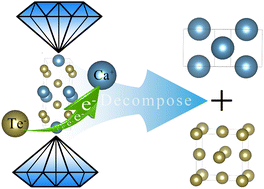Reverse charge transfer and decomposition in Ca–Te compounds under high pressure†
Abstract
Pressure alters the nature of chemical bonds and triggers novel reactions. Here, we employed first-principles calculations combined with the CALYPSO structural search technique to reveal the charge transfer reversal between Ca and Te under high pressure in the calcium-tellurium compound (CaxTe1−x, x = 1/4, 1/3, 1/2, 2/3). We predict several new phases with conventional and unconventional compounds and found an unfamiliar phenomenon: the Ca–Te compounds will reverse charge transfer between Ca and Te atoms and decompose into elemental solids under pressure. The Bader charge analyses indicate that the Ca2+ ion gains electrons and becomes an anion under high pressure. This leads to a weakened electrostatic interaction between Ca and Te and ultimately results in decomposition. The calculated band occupation number suggests that the occupation of Ca 3d orbitals under high pressure corresponds to this atypical phenomenon. Our results demonstrated the reverse charge transfer between Ca and Te and, in addition, clarified the mechanism of CaxTe1−x decomposition into solid Ca and Te elements under high pressure, providing important insights into the evolution of the properties of alkaline-earth chalcogenide compounds under high pressure.



 Please wait while we load your content...
Please wait while we load your content...